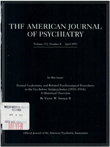Comorbidity of conduct disorder and personality disorders in an incarcerated juvenile population
Abstract
OBJECTIVE: Youths with conduct disorder extract an inordinate amount of time and money from the U.S. judicial system and taxpayers, yet studies pertaining to this population have been few. This study was undertaken to examine the co-occurrence of personality disorders and conduct disorder in a group of incarcerated children and adolescents and to raise the issue of the possibility of antisocial personality disorder in persons under the age of 18 years. METHOD: One hundred incarcerated juvenile offenders aged 11-17 years were randomly selected and then interviewed with the Diagnostic Interview for Children and Adolescents-- Revised and the Structured Clinical Interview for DSM-III-R Personality Disorders to establish their psychiatric diagnoses. RESULTS: Eighty- seven percent of the group met the criteria for conduct disorder. Among those diagnosed as having conduct disorder, the only comorbid personality disorder that was present with significant frequency was antisocial personality disorder. The other comorbid personality disorder diagnoses that appeared most frequently were the borderline, narcissistic, paranoid, passive-aggressive, and dependent types. Borderline personality disorder was observed more frequently in the females than in the males with conduct disorder. CONCLUSIONS: The findings suggest that by using DSM-III-R criteria for adult personality disorders, one finds a considerable number of personality disorders in a young population with conduct disorder. The findings also show that youths manifest signs of antisocial personality disorder before they are 18 years of age, raising the question of how age should be incorporated into the diagnosis of personality disorder as DSM-IV is being prepared.
Access content
To read the fulltext, please use one of the options below to sign in or purchase access.- Personal login
- Institutional Login
- Sign in via OpenAthens
- Register for access
-
Please login/register if you wish to pair your device and check access availability.
Not a subscriber?
PsychiatryOnline subscription options offer access to the DSM-5 library, books, journals, CME, and patient resources. This all-in-one virtual library provides psychiatrists and mental health professionals with key resources for diagnosis, treatment, research, and professional development.
Need more help? PsychiatryOnline Customer Service may be reached by emailing [email protected] or by calling 800-368-5777 (in the U.S.) or 703-907-7322 (outside the U.S.).



